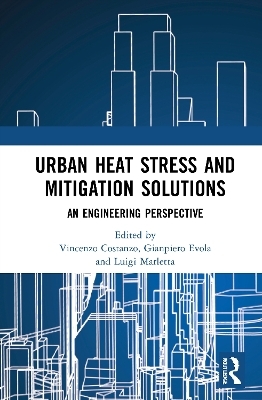
Urban Heat Stress and Mitigation Solutions
Routledge (Verlag)
978-0-367-49367-7 (ISBN)
This book provides the reader with an understanding of the impact that different morphologies, construction materials and green coverage solutions have on the urban microclimate, thus affecting the comfort conditions of urban inhabitants and the energy needs of buildings in urban areas. The book covers the latest approaches to energy and outdoor comfort measurement and modelling on an urban scale, and describes possible measures and strategies to mitigate the effects of the mutual interaction between urban settlements and local microclimate.
Despite its relevance, only limited literature is currently devoted to appraising—from an engineering perspective—the intertwining relationships between urban geometry and fabrics, energy fluxes between buildings and their surroundings, outdoor microclimate conditions and building energy demands in urban areas. This book fills this gap by first discussing the physical processes that govern heat and mass transfer at an urban scale, while emphasizing the role played by different spatial arrangements, manmade materials and green infrastructures on the outdoor microclimate. The first chapters also address the implications of these factors on the outdoor comfort conditions experienced by pedestrians, and on the buildings’ energy demand for space heating and cooling.
Then, based upon cutting-edge experimental activities and simulation work, this book demonstrates current and forthcoming adaptation and mitigation strategies to improve the urban microclimate and its impact on the built environment, such as cool materials, thermochromic and retroreflective finishing materials, and green infrastructures applied either at a building scale or at the urban scale. The effect of these solutions is demonstrated for different cities worldwide under a range of climate conditions. Finally, the book opens a wider perspective by introducing the basic elements that allow fuel poverty, raw materials consumption, and the principles of circular economy in the definition of a resilient urban settlement.
Vincenzo Costanzo is currently a Researcher at the Department of Civil Engineering and Architecture (DICAR) at the University of Catania, Italy. He holds a PhD in energetics focusing on building and environmental physics. Gianpiero Evola is Assdociate Professor of building physics at the Department of Electric, Electronic and Computer Engineering (DIEEI) at the University of Catania, Italy. He holds a PhD in building physics. Luigi Marletta is Professor of building physics at the Department of Electric, Electronic and Computer Engineering (DIEEI) at the University of Catania, Italy.
Part I: Physical processes and outdoor comfort in urban areas 1. Understanding heat and mass transfer at the urban scale 2. An overview of microclimate simulation tools and models for predicting outdoor thermal comfort 3. Measuring and assessing thermal exposure 4. Thermal comfort in the outdoor built environment: the role of clothing 5. Potential effects of anthropometric variables on outdoor thermal comfort Part II: Urban energy modelling 6. Urban form and climate performance 7. Including weather data morphing and other urban effects in energy simulations 8. The climate-related potential of natural ventilation 9. Different approaches to urban energy modelling 10. Low carbon heating and cooling strategies for urban residential buildings - A bottom-up engineering modelling approach 11. Definition, modelling and performance evaluation of energy distribution networks of prosumers Part III: Adaptation and mitigation measures 12. Cool materials in buildings. Roofs as a measure for urban energy rehabilitation 13. Building greenery systems 14. Thermochromic and retro-reflective materials 15. Urban green infrastructures for climate change adaptation: a multiscale approach 16. Part IV: Towards a resilient urbanscape 16. Environmental valuation and the city perspectives towards the circular economy 17. Urban energy poverty 18. Planning criteria for nature-based solutions in cities 19. The Colour of Heat: Visualising Urban Heat Islands for policy-making
| Erscheinungsdatum | 05.10.2021 |
|---|---|
| Zusatzinfo | 40 Tables, black and white; 58 Line drawings, black and white; 34 Halftones, black and white; 92 Illustrations, black and white |
| Verlagsort | London |
| Sprache | englisch |
| Maße | 156 x 234 mm |
| Gewicht | 800 g |
| Themenwelt | Naturwissenschaften ► Biologie ► Ökologie / Naturschutz |
| Naturwissenschaften ► Geowissenschaften ► Geografie / Kartografie | |
| Technik ► Architektur | |
| Technik ► Bauwesen | |
| Technik ► Elektrotechnik / Energietechnik | |
| Technik ► Umwelttechnik / Biotechnologie | |
| ISBN-10 | 0-367-49367-5 / 0367493675 |
| ISBN-13 | 978-0-367-49367-7 / 9780367493677 |
| Zustand | Neuware |
| Informationen gemäß Produktsicherheitsverordnung (GPSR) | |
| Haben Sie eine Frage zum Produkt? |
aus dem Bereich


